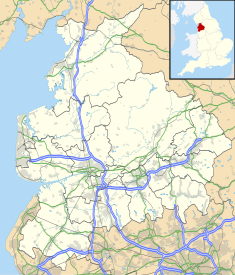Blackburn Town Hall
| Blackburn Town Hall | |
|---|---|
 The Italianate 19th-century town hall in the foreground and the 1960s tower block in the background | |
| Location | King William Street, Blackburn |
| Coordinates | 53°45′00″N 2°29′01″W / 53.7499°N 2.4837°W |
| Built | 1856 |
| Architect | James Patterson |
| Architectural style(s) | Italianate style |
Listed Building – Grade II | |
| Designated | 19 April 1974 |
| Reference no. | 1239734 |
Blackburn Town Hall is a municipal building in King William Street, Blackburn, England. The town hall, which is the headquarters of Blackburn with Darwen Borough Council, is a Grade II listed building.[1]
History
[edit]The foundation stone for the building was laid by Joseph Feilden of Witton Park, Lancashire on 28 October 1852.[2] The building, which was designed by James Patterson in the Italianate style and built by Richard Hacking and William Stones, was officially opened by William Hoole, the mayor, on 30 October 1856.[2] The design for the front of the building involved Corinthian order columns on first floor.[1] It originally housed a police station with 18 cells, a large assembly room, and a council chamber.[3] The town hall became the headquarters of the Municipal Borough of Blackburn on its completion, and the headquarters of Blackburn County Borough in 1889.[4]
King George V and Queen Mary visited the town hall in July 1913[5] and Queen Elizabeth II, accompanied by the Duke of Edinburgh, visited the building in April 1955.[6][7]
A tower block annexe was constructed in 1969: the two buildings were connected by an elevated, enclosed footbridge. The tower block was 198 feet (60 m) high and the top was 545 feet (166 m) 9 inches (23 cm) above sea-level when built.[8] The complex went on to be the headquarters of Lancashire borough of Blackburn in 1974 before becoming the headquarters of the new unitary authority, Blackburn with Darwen Borough Council, in 1998.[4]
A paving stone was laid outside the town hall in August 2017 to commemorate the life of Company Quartermaster-Sergeant William Grimbaldeston from Blackburn who was awarded the Victoria Cross during the First World War.[9] Additional paving stones were laid outside the town hall in April 2018 to commemorate the lives of Lieutenant-Commander Percy Dean and Second-Lieutenant John Schofield both of whom achieved the same distinction.[10] A fourth paving stone was laid outside the town hall in June 2019 to commemorate the life of Private James Pitts who had achieved the distinction in the Second Boer War.[11]
In May 2019, Blackburn with Darwen Borough Council announced plans to refurbish the third and fourth floors of the 19th century listed building which remains the main offices of the council.[12]
References
[edit]- ^ a b Historic England. "Town Hall, Blackburn (1239734)". National Heritage List for England. Retrieved 6 July 2020.
- ^ a b Abram (1877), p. 377
- ^ Duckworth (2005), p. 20.
- ^ a b "Blackburn with Darwen Guide" (PDF). 1 November 2010. p. 23. Retrieved 6 July 2020.
- ^ "Exhibition looks for mementos of the King's visit to Blackburn in 1913". Lancashire Telegraph. 12 June 2013. Retrieved 6 July 2020.
- ^ "Look at photographs of previous visits by the Queen to Blackburn". The Shuttle. 11 April 2014. Retrieved 6 July 2020.
- ^ "Royal Tour of Lancashire, 1955". British Pathe. Retrieved 6 July 2020.
- ^ Burrow, J & Co. (Eds.) (1970), p. 16.
- ^ "Blackburn man to be remembered for his bravery". The Shuttle. 8 August 2017. Retrieved 6 July 2020.
- ^ "Blackburn Victoria Cross heroes to be remembered". Lancashire Telegraph. 18 April 2018. Retrieved 6 July 2020.
- ^ "Private James Pitts commemorated with Blackburn town hall plaque". Lancashire Telegraph. 1 June 2019. Retrieved 6 July 2020.
- ^ "Blackburn town hall refurbishment plans unveiled by council". Lancashire Telegraph. 30 May 2019. Retrieved 6 July 2020.
Sources
[edit]- Abram, William Alexander (1877). A History of Blackburn: Town and Parish. J.G. & J. Toulmin.
- Burrow, J and Co., ed. (1970). Blackburn: Official Handbook. Cheltenham and London. ISBN 0-85026-110-4.
- Duckworth, Alan (2005). Blackburn: Town and City memories. The Francis Frith Collection. ISBN 1-85937-986-9.


